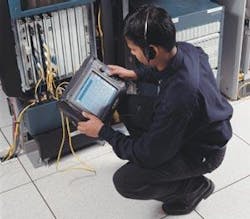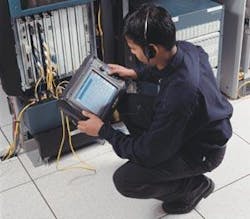In testing, modularity does matter
By TAMI FREEMAN -- When the alternative telco THUS decided to roll out Gigabit Ethernet services to its business customers across the UK, its first task was to choose the right testing equipment to support the installation, commissioning and troubleshooting of the new network. With the specific requirements of Gigabit Ethernet testing in mind, THUS decided to employ the CMA 5000, equipped with Gigabit Ethernet modules, from Danish test and measurement specialist NetTest.
"What really caught THUS's attention was the fact that the CMA 5000 is a modular platform," said NetTest regional sales manager Ian Humphreys. "The other hook is its ability to catch MPLS [MultiProtocol Label Switching] headers, which means it can be used as an edge tester. We were the only firm that could offer modularity, upgradability and future-proofing."
Put simply, the CMA 5000 provides a compact, single-box solution for testing multiple network layers. It uses a series of field-installable modules to analyse DWDM, SDH/SONET, Gigabit Ethernet and Fibre Channel networks, offering optical time-domain reflectometry, return-loss and dispersion measurements as part of the package. Each module is fully calibrated and simply slides into the back of a controller unit.
Tony Robinson, regional sales manager and CMA 5000 specialist at NetTest, explained the benefits: "Right from the CMA 5000's original conception, we considered how field engineers do their jobs. If you look at a switch room nowadays, you see racks with not only SDH, but Gigabit Ethernet and Fibre Channel gear, all feeding into the same DWDM systems. Engineers have to deal with many technologies and they must have a multitechnology test tool. It's impractical to lug around 10 different pieces of equipment."
Another selling point is the CMA 5000's built-in PC. Engineers fixing network faults in the field can switch the unit to act as a PC, for example to implement any changes on the network control software side, then switch it into test instrument mode to confirm that they produced the desired effects.
So far, THUS has purchased 12 C1MA 5000 testers (all equipped with the Gigabit Ethernet test module) and Humphreys is confident that more orders will follow. The service provider is using the equipment to test its customer links and locate any faults, as well as for RFC2544-based handovers.
The RFC2544 standard lists the specifications for network interconnect devices and describes tests for measuring and reporting performance characteristics. "People are seeing more and more service-level agreements written for Gigabit Ethernet circuits," said Robinson. "Initially, no-one knew what the acceptable limits were or which tests to run. But that is changing now--the ability to run RFC2544 is important."
Humphreys adds that while a full-blown RFC2544 test can take up to 10 hours, the CMA 5000 offers the option of a 25 minute pre-test, enabling engineers to weed out initial errored frames.
Once a Gigabit Ethernet system is up and running, THUS can also employ the CMA 5000 for troubleshooting and ongoing maintenance. Robinson explained that a reported fault may initially appear to be a problem with the network link. But, with Gigabit Ethernet in particular, the problem is often actually caused by how that link is being used.
Catching the culprit
If one customer is generating massive traffic and grabbing all the bandwidth, for example, the service provider needs to identify who this is. But pinpointing individual users is not an easy task. NetTest addressed this with the CMA 5000's unique channel statistics function, which provides statistics for every IP address, Ethernet address, virtual local-area network ID and MPLS label seen in the network. Carriers can view the traffic profile and easily locate those addresses with the highest traffic flow.
Robinson added: "We've found that the channel statistics is a very powerful option. People's eyes light up when they see it; it's gone down very well. I haven't come across a Gigabit Ethernet-related application that we haven't been able to do yet."
• This article originally appeared in the April 2004 edition of FibreSystems Europe in association with LIGHTWAVE Europe.
Tami Freeman is deputy editor, FibreSystems Europe in association with LIGHTWAVE Europe.
